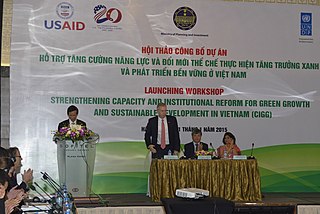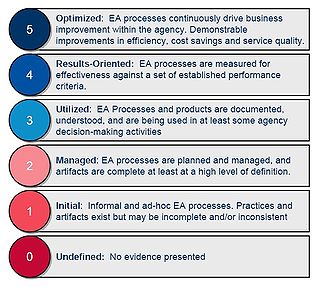Instructional design (ID), also known as instructional systems design and originally known as instructional systems development (ISD), is the practice of systematically designing, developing and delivering instructional materials and experiences, both digital and physical, in a consistent and reliable fashion toward an efficient, effective, appealing, engaging and inspiring acquisition of knowledge. The process consists broadly of determining the state and needs of the learner, defining the end goal of instruction, and creating some "intervention" to assist in the transition. The outcome of this instruction may be directly observable and scientifically measured or completely hidden and assumed. There are many instructional design models, but many are based on the ADDIE model with the five phases: analysis, design, development, implementation, and evaluation.
ISO 14000 is a family of standards by the International Organization for Standardization (ISO) related to environmental management that exists to help organizations (a) minimize how their operations negatively affect the environment ; (b) comply with applicable laws, regulations, and other environmentally oriented requirements; and (c) continually improve in the above.
Strategic planning is an organization's process of defining its strategy or direction, and making decisions on allocating its resources to attain strategic goals.

The No Child Left Behind Act of 2001 (NCLB) was a U.S. Act of Congress promoted by the Presidency of George W. Bush. It reauthorized the Elementary and Secondary Education Act and included Title I provisions applying to disadvantaged students. It mandated standards-based education reform based on the premise that setting high standards and establishing measurable goals could improve individual outcomes in education. To receive federal school funding, states had to create and give assessments to all students at select grade levels.
Program evaluation is a systematic method for collecting, analyzing, and using information to answer questions about projects, policies and programs, particularly about their effectiveness and efficiency.
Public value describes the value that an organization or activity contributes to society. The term was originally coined by Harvard professor Mark H. Moore who saw it as the equivalent of shareholder value in public management. Public value is supposed to provide managers with a notion of how entrepreneurial activity can contribute to the common good. Nowadays, public value is no longer limited to the public sector, but is used by all types of organization, including non-governmental organizations and private sector firms. Therefore, the public value researcher Timo Meynhardt from the University of St. Gallen and HHL Leipzig Graduate School of Management uses the term to generally raise the question about organizations' contribution to the common good. He believes that current management concepts, such as shareholder value, stakeholder value, customer value, sustainability or corporate social responsibility, should legitimize themselves in regard to their impact on the common good. In his (social-)psychological-based concept, public value emerges for individuals from the experiences made in social structures and relationships. Hence, it can be seen as a prerequisite and a resource for successful living.

Capacity building is the improvement in an individual's or organization's facility "to produce, perform or deploy". The terms capacity building and capacity development have often been used interchangeably, although a publication by OECD-DAC stated in 2006 that capacity development was the preferable term. Since the 1950s, international organizations, governments, non-governmental organizations (NGOs) and communities use the concept of capacity building as part of "social and economic development" in national and subnational plans. The United Nations Development Programme defines itself by "capacity development" in the sense of "'how UNDP works" to fulfill its mission. The UN system applies it in almost every sector, including several of the Sustainable Development Goals to be achieved by 2030. For example, the Sustainable Development Goal 17 advocates for enhanced international support for capacity building in developing countries to support national plans to implement the 2030 Agenda.
In education, Response to Intervention is an academic approach used to provide early, systematic, and appropriately intensive supplemental instruction and support to children who are currently or may be at risk of performing below grade or age level standards. However, to better reflect the transition toward a more comprehensive approach to intervention, there has been a shift in recent years from the terminology referring to RTI to MTSS, which stands for "multi-tiered system of supports". MTSS represents the latest intervention framework that is being implemented to systematically meet the wider needs which influence student learning and performance.
Competence is the set of demonstrable characteristics and skills that enable and improve the efficiency or performance of a job. Competency is a series of knowledge, abilities, skills, experiences and behaviors, which leads to effective performance in an individual's activities. Competency is measurable and can be developed through training.
Donald L. Kirkpatrick was Professor Emeritus at the University of Wisconsin in the United States and a past president of the American Society for Training and Development (ASTD). He is best known for creating a highly influential 'four level' model for training course evaluation, which served as the subject of his Ph.D. dissertation in 1954. Kirkpatrick's ideas were published to a broader audience in 1959 in a series of articles in the US Training and Development Journal, but they are better known from a book he published in 1994 entitled Evaluating Training Programs. Other books that he has written on training evaluation include Transferring Learning to Behavior and Implementing the Four Levels. His work is carried on by his eldest son, Dr. Jim Kirkpatrick, and Wendy Kayser Kirkpatrick, and Vanessa Alzate.
Enterprise systems engineering (ESE) is the discipline that applies systems engineering to the design of an enterprise. As a discipline, it includes a body of knowledge, principles, and processes tailored to the design of enterprise systems.
The rational planning model is a model of the planning process involving a number of rational actions or steps. Taylor (1998) outlines five steps, as follows:
A needs assessment is a systematic process for determining and addressing needs, or "gaps", between current conditions and desired conditions or "wants".
The Comprehensive School Reform (CSR) program was a program administered by the U.S. Department of Education's Office of Elementary and Secondary Education.
Human performance technology (HPT), also known as human performance improvement (HPI), or human performance assessment (HPA), is a field of study related to process improvement methodologies such as organization development, motivation, instructional technology, human factors, learning, performance support systems, knowledge management, and training. It is focused on improving performance at the societal, organizational, process, and individual performer levels.
The term managerial assessment of proficiency (MAP) describes a methodology for the assessment of managerial competence in human resource and training applications. MAP is designed for evaluation of a manager's proficiency in 12 prescribed competencies, and other criteria. Assessments can be generated for an employee, as well as for a department or the organisation as a whole. Normative values, used for comparative purposes in each assessment, are based upon the performance of over 110,000 managers, across 17 countries, in more than 600 organisations that have used MAP, according to the UK-based company, Development Processes Group plc, that licenses the tool into organisations. The Managerial Assessment of Proficiency - (MAP2), copyright 2012, 2014, HRD Press, Inc. is an assessment tool published by HRD Press, Inc. Amherst, MA USA, and is available throughout the world. "Development Processes Group plc" is the exclusive representative in the United Kingdom.

The Enterprise Architecture Assessment Framework (EAAF) was created by the US Federal government Office of Management and Budget (OMB) to allow federal agencies to assess and report their enterprise architecture activity and maturity, and advance the use of enterprise architecture in the federal government.
The International Society for Performance Improvement (ISPI) is a non-profit association for performance improvement professionals dedicated to improving individual, organizational, and societal functioning, productivity, and accomplishment in the workplace.

The term learning environment can refer to an educational approach, cultural context, or physical setting in which teaching and learning occur. The term is commonly used as a more definitive alternative to "classroom", but it typically refers to the context of educational philosophy or knowledge experienced by the student and may also encompass a variety of learning cultures—its presiding ethos and characteristics, how individuals interact, governing structures, and philosophy. In a societal sense, learning environment may refer to the culture of the population it serves and of their location. Learning environments are highly diverse in use, learning styles, organization, and educational institution. The culture and context of a place or organization includes such factors as a way of thinking, behaving, or working, also known as organizational culture. For a learning environment such as an educational institution, it also includes such factors as operational characteristics of the instructors, instructional group, or institution; the philosophy or knowledge experienced by the student and may also encompass a variety of learning cultures—its presiding ethos and characteristics, how individuals interact, governing structures, and philosophy in learning styles and pedagogies used; and the societal culture of where the learning is occurring. Although physical environments do not determine educational activities, there is evidence of a relationship between school settings and the activities that take place there.
The Knirk & Gustafson Instructional Design Model is an instructional model that was developed by Frederick G. Knirk and Kent L. Gustafson in 1986. Their model has three stages:



